
| Version | Summary | Created by | Modification | Content Size | Created at | Operation |
|---|---|---|---|---|---|---|
| 1 | Camila Xu | -- | 1770 | 2022-10-20 01:35:48 |
Video Upload Options
Military transport aircraft or military cargo aircraft are typically fixed wing and rotary wing cargo aircraft which are used to airlift troops, weapons and other military equipment by a variety of methods to any area of military operations around the surface of the planet, usually outside the commercial flight routes in uncontrolled airspace. Originally derived from bombers, military transport aircraft were used for delivering airborne forces during World War II and towing military gliders. Some military transport aircraft are tasked to perform multi-role duties such as aerial refueling and, rescue missions, tactical, operational and strategic airlifts onto unprepared runways, or those constructed by engineers.
1. Fixed-Wing
Fixed-wing transport aircraft are defined in terms of their range capability as strategic airlift or tactical airlift to reflect the needs of the land forces which they most often support. These roughly correspond to the commercial flight length distinctions: Eurocontrol defines short-haul routes as shorter than 1,500 km (810 nmi), long-haul routes as longer than 4,000 km (2,200 nmi) and medium-haul between.[1]
A more specialised role of a cargo aircraft is that of transporting fuel in support of other aircraft with more limited flight endurance such as fighters or helicopters. Smaller cargo aircraft, known as "utility", are often used to transport military communications equipment as temporary or permanent platforms, and in the command role by providing airborne command post or as an air ambulance.
1.1. Transports and Tankers
| Type | Country | Role | Introduction Date | Number Built | Payload (t) | Maximum Take-Off Weight (t) | Cruise Speed (km/h) | Service Ceiling (m) | Range (km) |
|---|---|---|---|---|---|---|---|---|---|
| Aeritalia G.222 | Italy | Tactical | 1978 | 111 | 9 | 28 | 439 | 7,620 | 1,371 |
| Airbus A310 MRTT | European Union | Strategic / Tank | 2003 | 36 | 164 | 850 | 12,530 | 6,500 | |
| Airbus A330 MRTT | European Union | Strategic / Tank | 2007 | 45 | 223 | 860 | 13,000 | 14,800 | |
| Airbus A400M | European Union | Strategic / Tactical | 2009 | 67 | 37 | 141 | 780 | 12,200 | 9,300 |
| Alenia C-27J Spartan | Italy | Tactical | 2008 | 101 | 11.5 | 31.8 | 583 | 9,144 | 5,926 |
| Antonov An-8 Camp | Ukraine | Tactical | 1958 | 151 | 11 | 88 | 480 | 9,600 | 2,780 |
| Antonov An-12 Cub | Ukraine | Tactical | 1959 | 1248 | 20 | 61 | 670 | 10,200 | 5,700 |
| Antonov An-14 Clod | Ukraine | Tactical / Utility | 1966 | 332 | 7 | 3.6 | 180 | 5,000 | 650 |
| Antonov An-22 Antei | Ukraine | Strategic / Tactical | 1965 | 68 | 80 | 250 | 740 | 10,200 | 5,000 |
| Antonov An-26 Curl | Ukraine | Tactical | 1969 | 1403 | 5.5 | 24 | 440 | 7,500 | 2,550 |
| Antonov An-28 Cash | Ukraine | Tactical / Utility | 1986 | 191 | 2.5 | 8 | 270 | 7,620 | 1,500 |
| Antonov An-32 Cline | Ukraine | Tactical | 1976 | 361 | 6.7 | 26.9 | 480 | 9,500 | 2,500 |
| Antonov An-72 Coaler | Ukraine | Tactical | 1977 | 195 | 7.5 | 33 | 600 | 10,100 | 4,800 |
| Antonov An-124 Ruslan | Ukraine | Strategic | 1982 | 55 | 150 | 405 | 800-850 | 12,000 | 5,410 |
| Antonov An-70 | Ukraine | Strategic / Tactical | 1994 | 2 | 47 | 145 | 729 | 12,000 | 6,600 |
| Antonov An-178 | Ukraine | Tactical | 2015 | 1 | 18 | 42 | 800 | 13,000 | 5,500 |
| Antonov/Taqnia An-132 | Ukraine/Saudi Arabia | Tactical | 2016 | 9.2 | 28.5 | 550 | 9,000 | 4,400 | |
| Armstrong Whitworth AW.660 Argosy | United Kingdom | Strategic / Tactical | 1960 | 72 | 13 | 48 | 407 | 7,010 | 5,552 |
| Avro York | United Kingdom | Strategic / Tactical | 1944 | 259 | 9.1 | 29.4 | 322 | 7,010 | 4,800 |
| Avro Vulcan K.2 | United Kingdom | Tank | 1984 | 136 | 93 | 1053.5 | 14,000-17,000 | ||
| Beechcraft C-12 Huron | United States | Tactical / Utility | 1974 | 2 | 5 | 375 | 10,668 | 3,185 | |
| Bell Boeing V-22 Osprey | United States | Tactical | 1989 | 200+ | 6.8 | 27.4 | 396 | 7,620 | 1,627 |
| Boeing 247/C-73 | United States | Strategic / Tactical | 1942 | 6.2 | 304 | 7,620 | 1,200 | ||
| Boeing C-108 Flying Fortress | United States | Strategic / Tactical | 1943 (prototype only) | 5 | 30 | 293 | 10,850 | 3,219 | |
| Boeing KB-29 Superfortress | United States | Tank | 1948 | 5.4 | 62 | 507 | 12,000 | 3,710 | |
| Boeing C-97 Stratofreighter | United States | Strategic / Tank | 1951 | 888 | 9.1 | 79 | 482 | 10,670 | 6,920 |
| Boeing KB-50 Superfortress | United States | Tank | 1956 | 5.4 | 62 | 507 | 12,000 | 3,710 | |
| Boeing KC-135 Stratotanker | United States | Strategic / Tank | 1956 | 803 | 37.6 | 146 | 853 | 15,200 | 17,766 |
| Boeing YC-14 | United States | Tactical | 1976 (prototype only) | 31.4 | 133 | 723 | 13,716 | 5,136 | |
| Boeing VC-25 | United States | VIP transport | 1990 | 375 | 925 | 13,700 | 13,000 | ||
| Boeing C-17 Globemaster III | United States | Strategic / Tactical | 1991 | 279 | 77.5 | 265 | 830 | 13,716 | 10,390 |
| Boeing C-32 | United States | VIP transport | 1998 | 116 | 851 | 13,000 | 7,250 | ||
| Boeing C-40 Clipper | United States | Strategic | 2001 | 18 | 78 | 838 | 12,500 | 5,600 | |
| Boeing KC-767 | United States | Strategic / Tank | 2005 | 29.5 | 182 | 851 | 12,200 | 11,830 | |
| Boeing KC-46 Pegasus | United States | Strategic / Tank | 2013 | 29.5 | 182 | 851 | 12,200 | 11,830 | |
| British Aerospace 125 | United Kingdom | VIP transport | 1965 | 11 | 747 | 12,500 | 2,891 | ||
| British Aerospace 146 | United Kingdom | VIP transport | 1986 | 97.5 | 747 | 11,000 | 3,870 | ||
| Britten-Norman BN-2 Islander | United Kingdom | Tactical / Utility | 1965 | 2 | 3 | 257 | 4,024 | 1,400 | |
| Canadair North Star | Canada | Strategic / Tactical | 1946 | 5 | 33 | 523 | 10,970 | 6,212 | |
| Canadair CL-44/CC-106 Yukon | Canada | Strategic / Tactical | 1960 | 95 | 670 | 9,100 | 8,990 | ||
| Canadair CC-109 Cosmopolitan | Canada | Tactical | 1960 | 6.4 | 24 | 518 | 7,620 | 3,660 | |
| CASA C-212 Aviocar | Spain | Tactical / Utility | 1971 | 2.8 | 8 | 315 | 7,925 | 1,433 | |
| CASA CN-235 | Spain | Tactical | 1983 | 5 | 15.1 | 509 | 7,620 | 5,003 | |
| Cessna Citation V/UC-35 | United States | VIP transport | 1987 | 7.3 | 796 | 13,715 | 3,650 | ||
| Consolidated C-87 Liberator Express | United States | Strategic / Tactical | 1942 | 4.5 | 25 | 346 | 8,500 | 5,311 | |
| Consolidated R2Y | United States | Strategic / Tactical | 1944 (prototype only) | 5.5 | 29 | 380 | 8,500 | 6,400 | |
| Convair XC-99 | United States | Strategic | 1949 (prototype only) | 45 | 145.5 | 370 | 9,150 | 13,041 | |
| Convair C-131 Samaritan | United States | Tactical | 1950 | 21 | 409 | 7,470 | 750 | ||
| Curtiss C-46 Commando | United States | Strategic / Tactical | 1941 | 6.8 | 20 | 278 | 7,468 | 5,069 | |
| de Havilland Canada DHC-4 Caribou | Canada | Tactical | 1958 | 3.6 | 14.2 | 348 | 7,559 | 2,103 | |
| de Havilland Canada DHC-5 Buffalo | Canada | Tactical | 1965 | 8.2 | 22.3 | 9,450 | 1,112 | ||
| de Havilland Canada DHC-6 Twin Otter | Canada | Tactical / Utility | 1966 | 5.5 | 278 | 7,620 | 1,434 | ||
| Douglas DC-2/C-32 | United States | Strategic / Tactical | 1937 | 8 | 278 | 6,930 | 1,750 | ||
| Douglas C-47 Skytrain | United States | Strategic / Tactical | 1941 | 3 | 10.5 | 360 | 8,045 | 2,600 | |
| Douglas C-54 Skymaster | United States | Strategic / Tactical | 1942 | 33 | 310 | 6,800 | 6,400 | ||
| Douglas C-74 Globemaster | United States | Strategic | 1945 | 22 | 78 | 6,490 | 5,470 | ||
| Douglas C-47 Skytrain/C-117 Skytrain | United States | Strategic / Tactical | 1951 | 3 | 10.5 | 360 | 8,045 | 2,600 | |
| Douglas C-118 Liftmaster | United States | Strategic / Tactical | 1947 | 12.7 | 48.5 | 507 | 5,460 | 6,700 | |
| Douglas C-124 Globemaster II | United States | Strategic | 1950 | 448 | 88.2 | 370 | 6,645 | 10,975 | |
| Douglas C-133 Cargomaster | United States | Strategic | 1956 | 50 | 53.5 | 130 | 519 | 9,800 | 6,590 |
| EADS CASA C-295 | Spain | Tactical | 1998 | 9.3 | 23.2 | 481 | 9,100 | 5,400 | |
| Embraer KC-390 | Brazil | Tactical | 2014 | 23 | 72 | 900 | 10,973 | 6,200 | |
| Fairchild C-82 Packet | United States | Tactical | 1944 | 12.5 | 24.5 | 351 | 6,460 | 6,239 | |
| Fairchild C-119 Flying Boxcar | United States | Tactical | 1949 | 12.5 | 33.5 | 322 | 7,300 | 2,849 | |
| Focke-Wulf Fw 200 Condor | Germany | Strategic / Tactical | 1937 | 23 | 335 | 6,000 | 3,560 | ||
| Fokker F27 Friendship | Netherlands | Tactical | 1958 | 20 | 460 | 7,620 | 2,055 | ||
| Fokker 50 | Netherlands | Tactical | 1985 | 23 | 530 | 7,620 | 1,666 | ||
| Grumman C-1 Trader | United States | Carrier Onboard Delivery | 1952 | 1.6 | 13.2 | 462 | 6,700 | 2,092 | |
| Grumman C-2 Greyhound | United States | Carrier Onboard Delivery | 1964 | 4.5 | 24.7 | 465 | 10,210 | 2,400 | |
| Gulfstream III/C-20 | United States | VIP transport | 1980 | 31.5 | 818 | 13,716 | 6,760 | ||
| Handley Page Hastings | United Kingdom | Strategic / Tactical | 1948 | 9 | 36.2 | 468 | 8,100 | 2,720 | |
| Handley Page Victor K.2 | United Kingdom | Tank | 1965 | 93 | 17,000 | 9,660 | |||
| Harbin Y-12 | China | Tactical / Utility | 1983 | 5.5 | 250 | 7,000 | 1,340 | ||
| Ilyushin Il-12 Coach | Russia | Tactical | 1946 | 17 | 6,500 | 1,500 | |||
| Ilyushin Il-14 Crate | Russia | Tactical | 1954 | 18 | 7,400 | 1,300 | |||
| Ilyushin Il-76 Candid | Russia | Strategic / Tactical | 1971 | 960 | 47 | 170 | 900 | 13,000 | 4,400 |
| Ilyushin Il-78 Midas | Russia | Tank | 1971 | 53 | 47 | 170 | 900 | 13,000 | 4,400 |
| Ilyushin Il-76-MD-90A | Russia | Strategic / Tactical | 2013 | 60 | 210 | 850 | 13,000 | 4,000 | |
| Ilyushin Il-78M-90A | Russia | Tank | 2017 | 47 | 170 | 900 | 13,000 | 4,400 | |
| Ilyushin Il-112 | Russia | Tactical | 2011 | 5.9 | 20 | 550 | 7,600 | 5,000 | |
| Ilyushin Il-276 | Russia | Tactical | 2025 (planned) | 20 | 15.8 | 800 | 13,000 | 2,000 | |
| Junkers Ju 52 | Germany | Strategic / Tactical | 1930 | 2 | 11 | 211 | 5,490 | 800 | |
| Junkers Ju 89 | Germany | Strategic / Tactical | 1938 (prototype only) | 1.5 | 29 | 7,000 | 2,980 | ||
| Junkers Ju 90 | Germany | Strategic / Tactical | 1937 | 33 | 320 | 5,750 | 1,247 | ||
| Junkers Ju 290 | Germany | Strategic / Tactical | 1942 | 3 | 50 | 6,000 | 6,150 | ||
| Junkers Ju 390 | Germany | Strategic | 1943 (prototype only) | 75.5 | 6,000 | 9,700 | |||
| Kawasaki Ki-56 | Japan | Strategic / Tactical | 1940 | 8 | 8,000 | 3,300 | |||
| Kawasaki C-1 | Japan | Tactical | 1970 | 11.9 | 45 | 657 | 11,580 | 1,300 | |
| Kawasaki C-2 | Japan | Tactical | 2010 | 37.6 | 120 | 890 | 12,200 | 6,500 | |
| Learjet C-21 | United States | VIP transport | 1973 | 8 | 774 | 13,700 | 5,295 | ||
| Lisunov Li-2 | Soviet Union | Strategic / Tactical | 1939 | 3 | 10.5 | 360 | 8,045 | 2,600 | |
| Lockheed Model 18 Lodestar | United States | Strategic / Tactical | 1940 | 10 | 322 | 7,740 | 4,025 | ||
| Lockheed C-69 Constellation | United States | Strategic / Tactical | 1943 | 33 | 504 | 7,629 | 3,900 | ||
| Lockheed C-121 Constellation | United States | Strategic / Tactical | 1948 | 48.5 | 512 | 7,450 | 4,445 | ||
| Lockheed R6V Constitution | United States | Strategic | 1946 (prototype only) | 83.4 | 418 | 8,700 | 8,670 | ||
| Lockheed C-130 Hercules | United States | Tactical / Tank | 1954 | 2500+ | 20.4 | 70.3 | 540 | 10,060 | 3,800 |
| Lockheed JetStar/C-140 | United States | VIP transport | 1961 | 20 | 811 | 13,105 | 4,820 | ||
| Lockheed C-141 Starlifter | United States | Strategic / Tactical | 1963 | 285 | 28.4 | 147 | 912 | 12,500 | 9,880 |
| Lockheed C-5 Galaxy | United States | Strategic | 1968 | 131 | 122 | 381 | 907 | 10,600 | 4,445 |
| Lockheed TriStar (RAF) | United States | Strategic / Tank | 1984 | 136 | 894 | 13,000 | 7,785 | ||
| Lockheed Martin C-130J Super Hercules | United States | Tactical / Tank | 1996 | 40 | 19-20 | 70.3-74.3 | 643 | 8,615 | 3,334 |
| McDonnell Douglas C-9 | United States | Strategic | 1968 | 50 | 811 | 11,000 | 4,700 | ||
| McDonnell Douglas YC-15 | United States | Tactical | 1975 (prototype only) | 35 | 98 | 872 | 9,144 | 4,810 | |
| McDonnell Douglas KC-10 Extender | United States | Strategic / Tank | 1980 | 77 | 268 | 908 | 12,800 | 18,507 | |
| Messerschmitt Me 323 | Germany | Strategic / Tactical | 1943 | 10 | 43 | 218 | 4,000 | 800 | |
| Mitsubishi Ki-57 | Japan | Strategic / Tactical | 1942 | 9 | 8,000 | 3,000 | |||
| Nakajima Ki-34 | Japan | Strategic / Tactical | 1937 | 5 | 310 | 7,000 | 1,200 | ||
| PZL M-28 Skytruck | Poland | Tactical / Utility | 1993 | 2.5 | 8 | 270 | 7,620 | 1,500 | |
| Nord Noratlas | France | Tactical | 1953 | 12.5 | 21 | 320 | 7,100 | 2,500 | |
| Savoia-Marchetti SM.81 | Italy | Strategic / Tactical | 1935 | 2 | 10.5 | 550 | 7,000 | 1,500 | |
| Shaanxi Y-8 | China | Tactical | 1974 | 20 | 61 | 550 | 10,200 | 5,616 | |
| Shaanxi Y-9 | China | Tactical | 2008 | 25 | 77 | 650 | 10,200 | 7,800 | |
| Short Belfast | United Kingdom | Strategic | 1964 | 55 | 104 | 541 | 9,144 | 8,528 | |
| Short Skyvan | United Kingdom | Tactical / Utility | 1963 | 5 | 5.6 | 317 | 6,858 | 1117 | |
| Short C-23 Sherpa | United Kingdom | Tactical / Utility | 1982 | 3.2 | 3.2 | 296 | 5,114 | 1,239 | |
| Showa/Nakajima L2D | Japan | Strategic / Tactical | 1939 | 3 | 10.5 | 360 | 8,045 | 2,600 | |
| Transall C-160 | France/Germany | Tactical | 1963 | 214 | 16 | 49.2 | 513 | 10,060 | 8,230 |
| Vickers Valetta | United Kingdom | Strategic / Tactical | 1948 | 3 | 16.5 | 277 | 6,550 | 2,350 | |
| Vickers Valiant B(K).1/B(PR)K.1 | United Kingdom | Tank | 1958 | 64 | 16,500 | 7,245 | |||
| Vickers VC10 | United Kingdom | Strategic / Tank | 1965 | 151 | 13,105 | 9,412 | |||
| Xian HY-6 | China | Tank | 1995 | 180 | 9 | 79 | 768 | 12,800 | 6,000 |
| Xian Y-20 | China | Strategic / Tactical | 2013 | 10 | 66 | 220 | 900 | 13,000 | 7,800 |
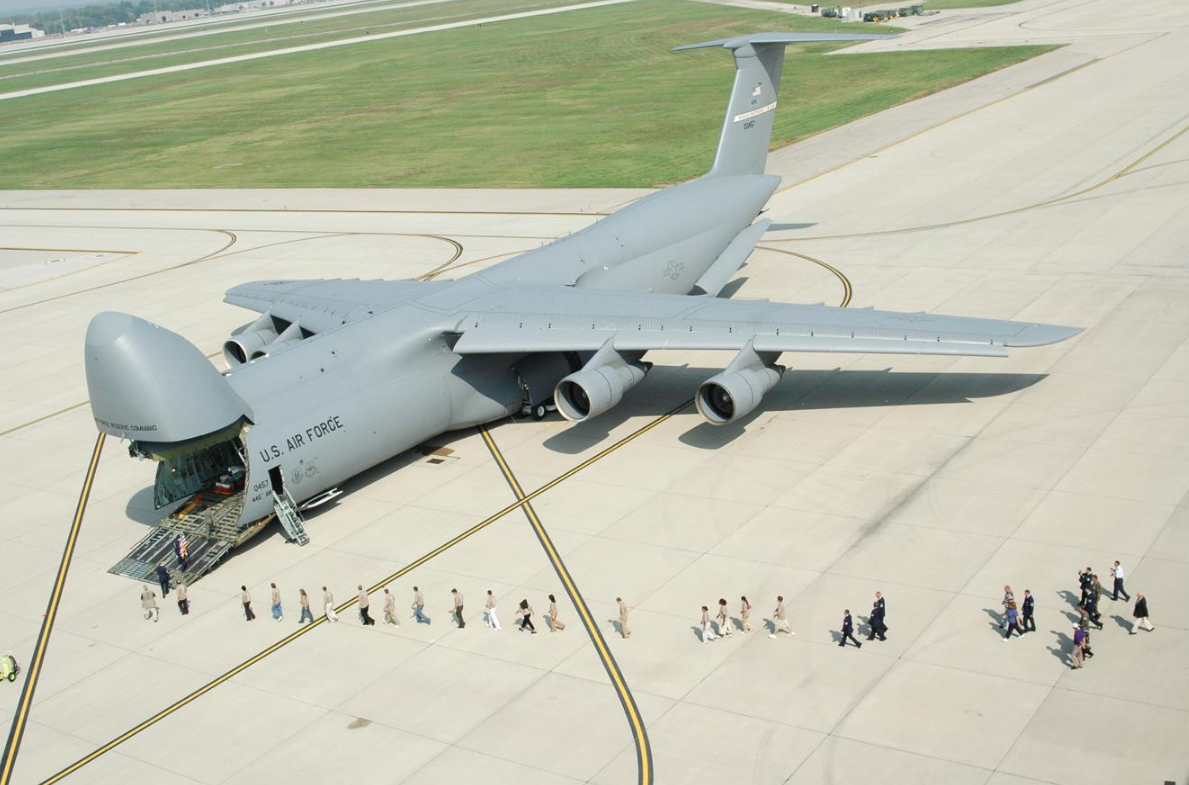
The C-5 Galaxy.
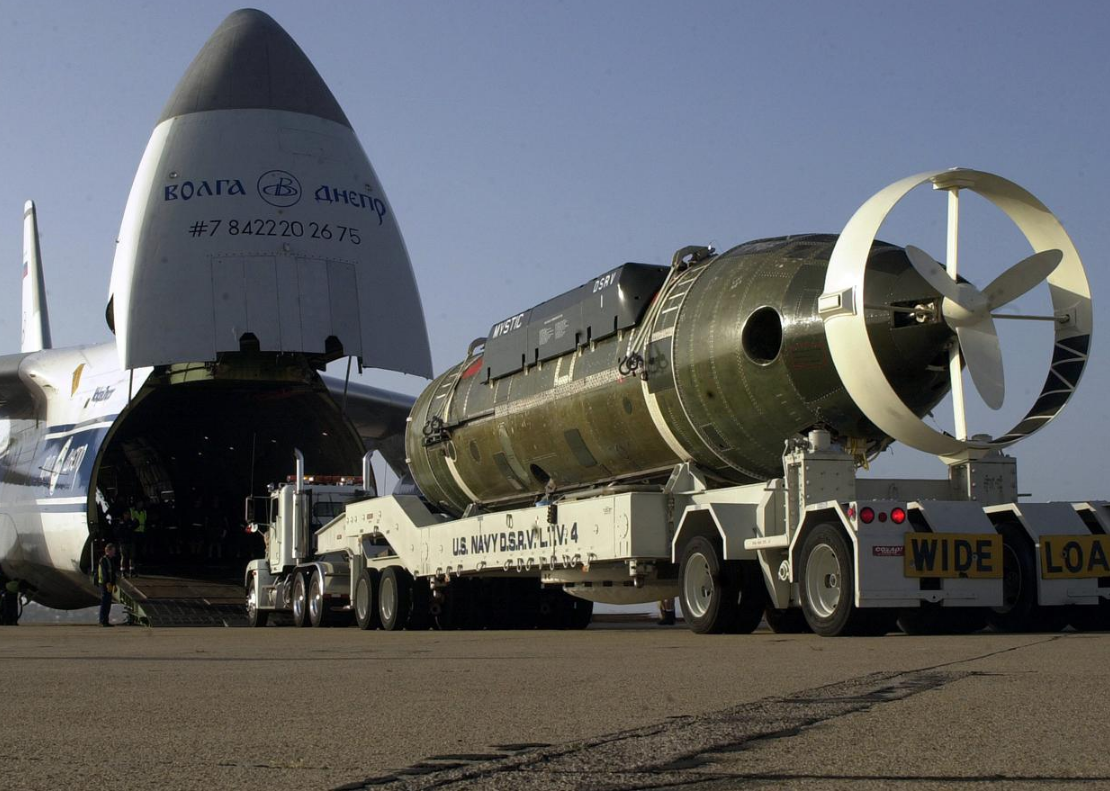
The Deep Submergence Rescue Vehicle "Mystic" being loaded into an An-124, California.
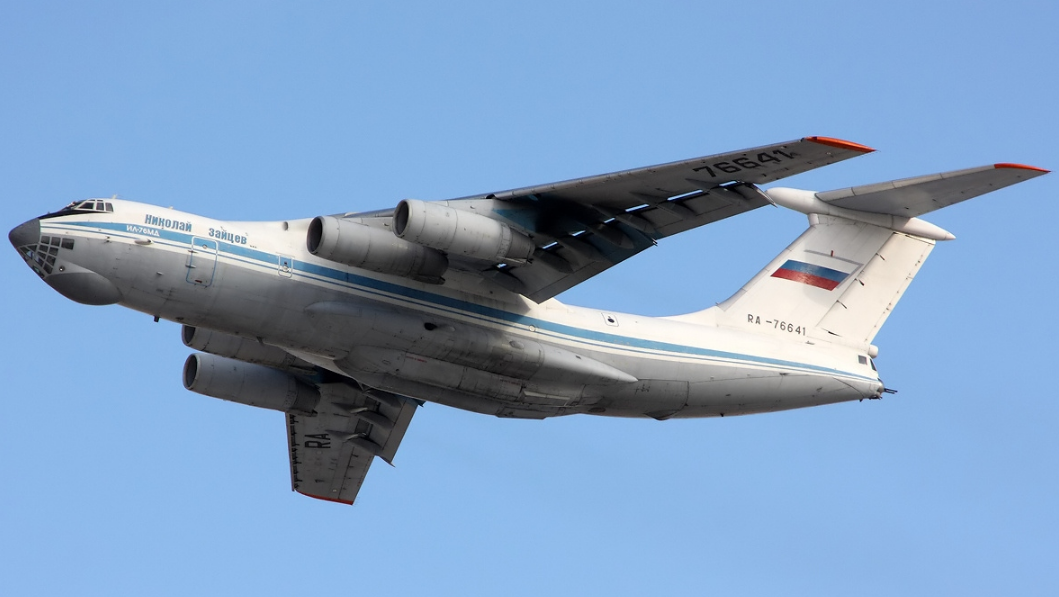
Il-76 of the Russian Air Force .
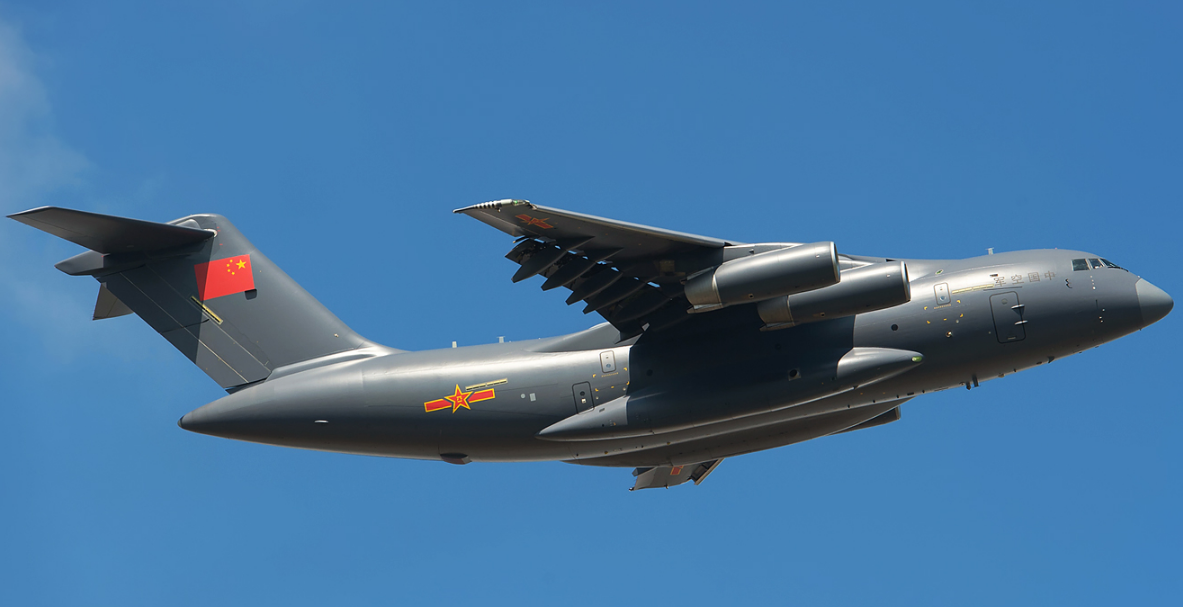
Xian Y-20 at the 2016 Zhuhai Air Show.
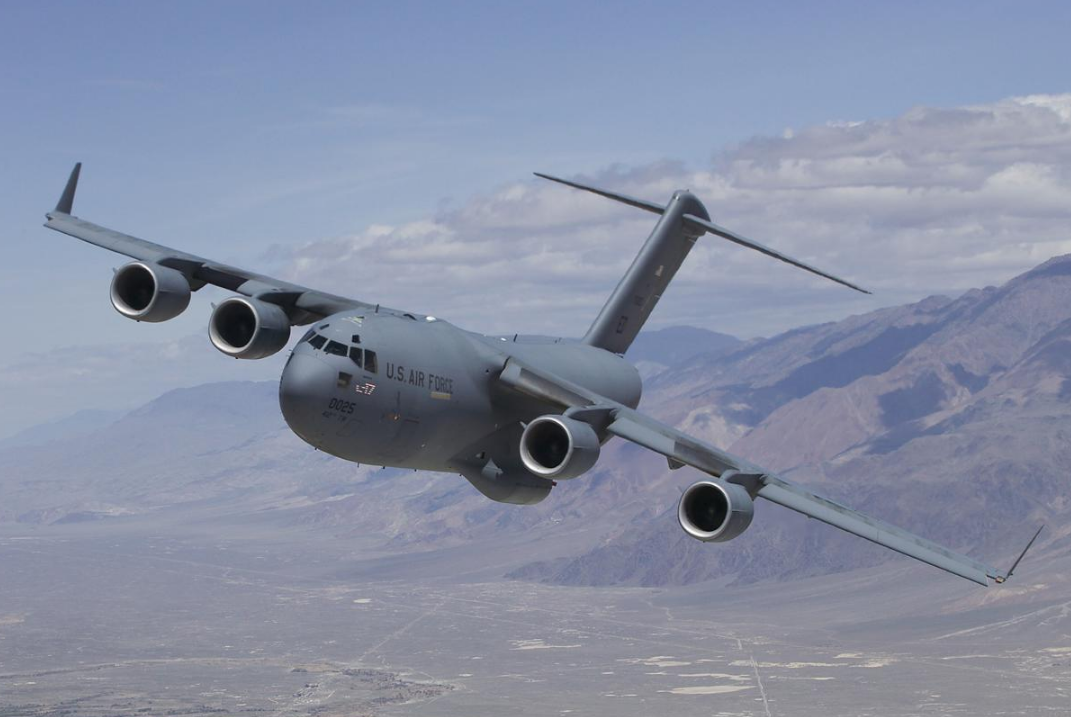
A USAF Boeing C-17 Globemaster III military cargo aircraft.
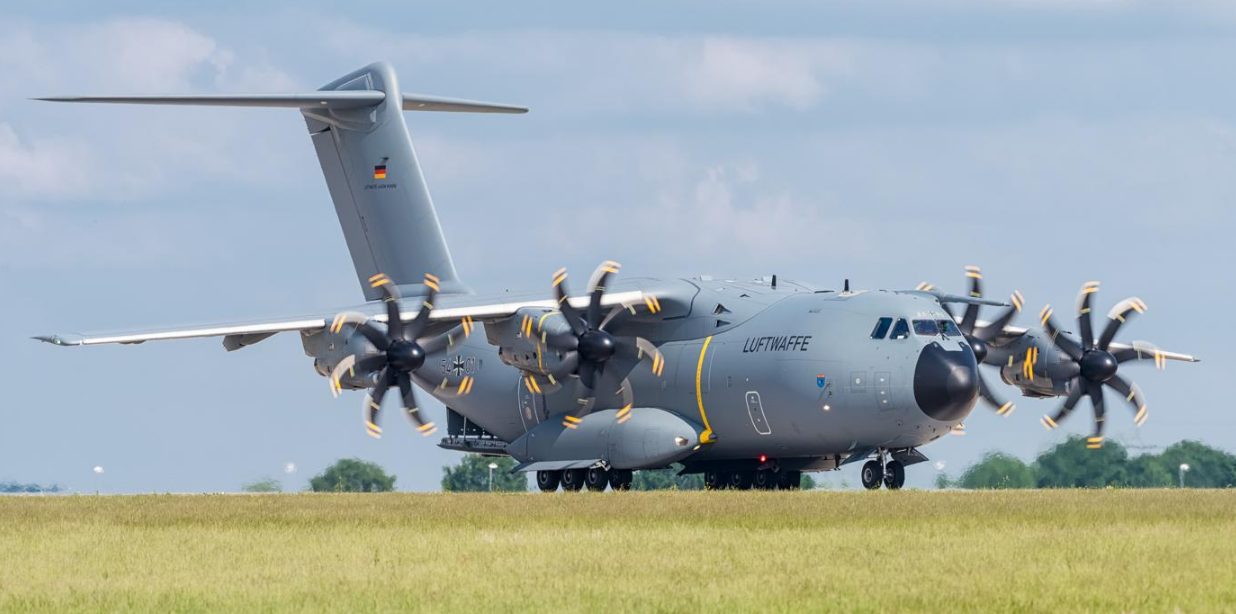
A400M of the German Air Force .
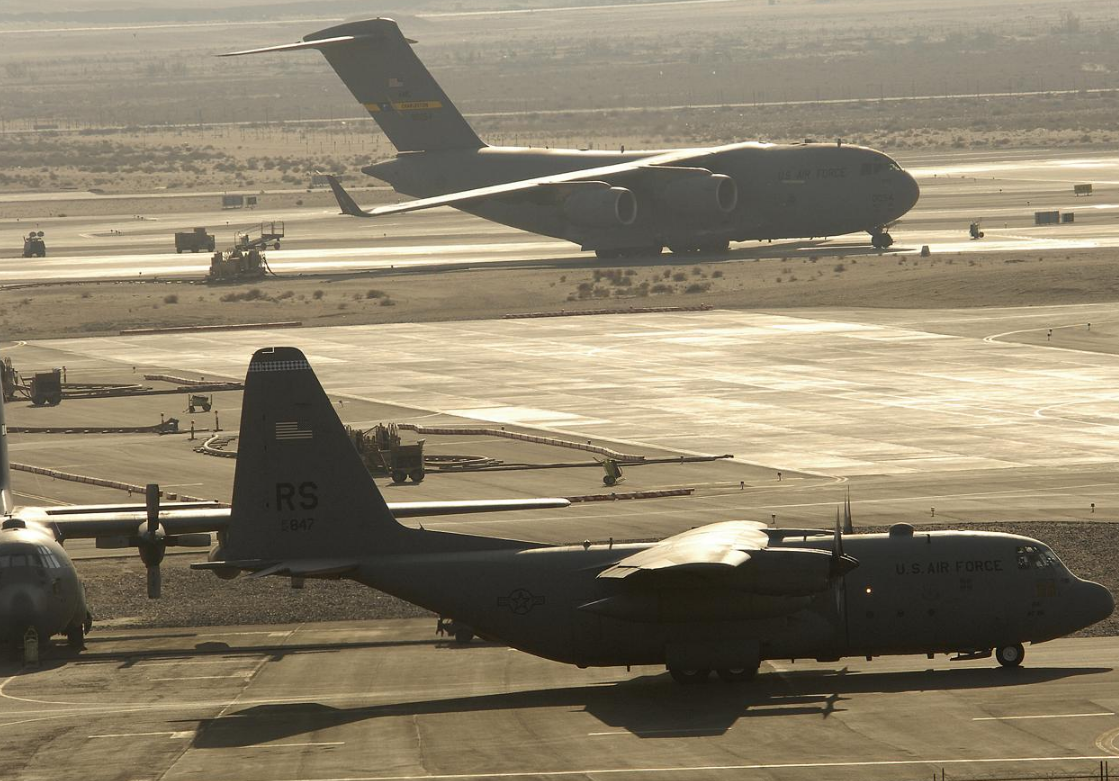
C-17 and C-130 Ready to Depart.
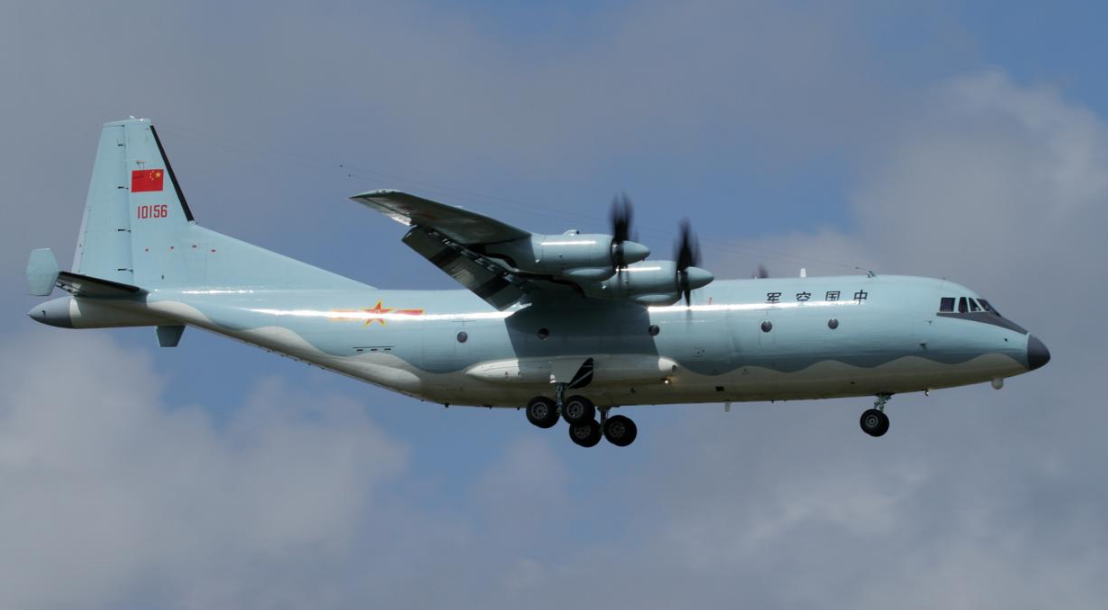
Shaanxi Y-9 landing at Zhuhai Jinwan Airport ahead of Airshow China 2016.

C-160 Transall of the German Air Force .

Antonov An-12 of the Russian Air Force .
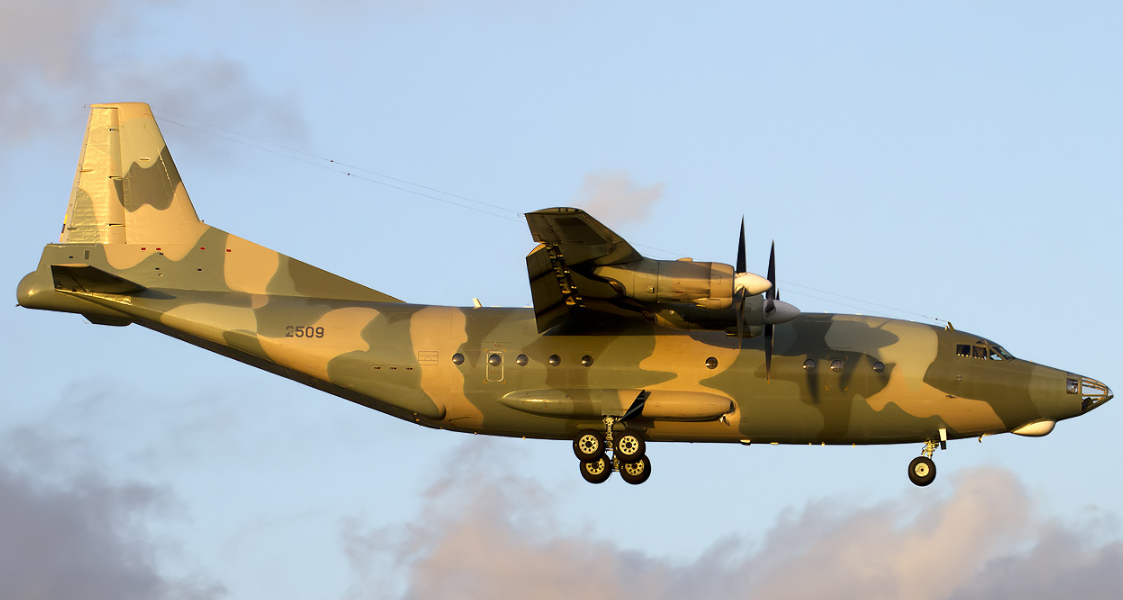
Venezuelan Air Force Shaanxi Y-8 on finals at Natal.

CC-150 Polaris tanker refueling two CF-18 Hornets.
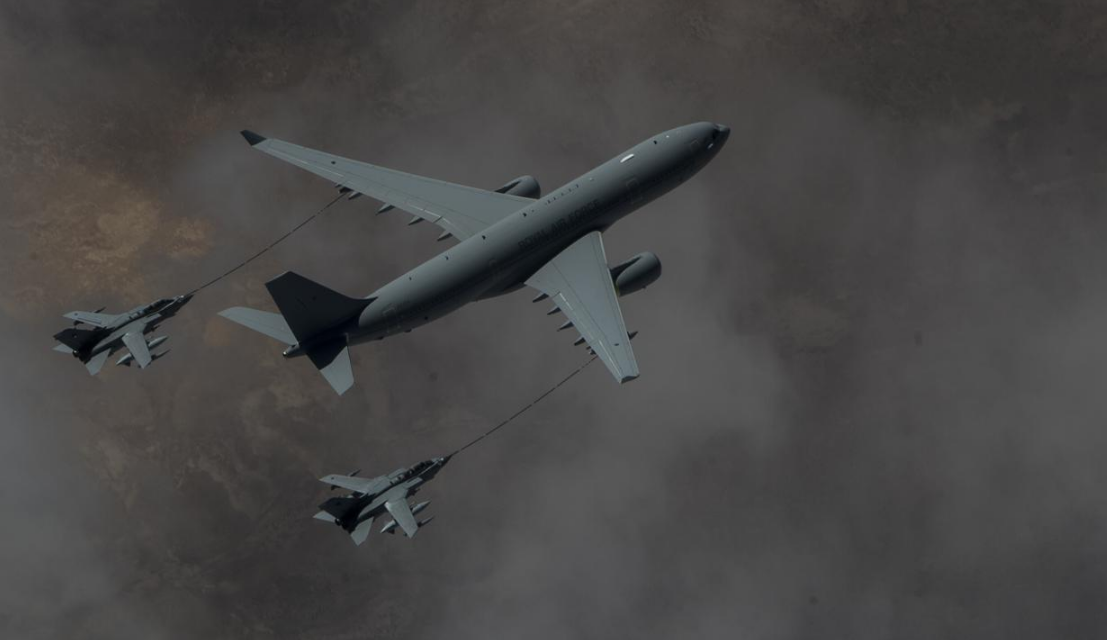
RAF Voyager KC2 refuels two Tornado GR4 over Iraq.
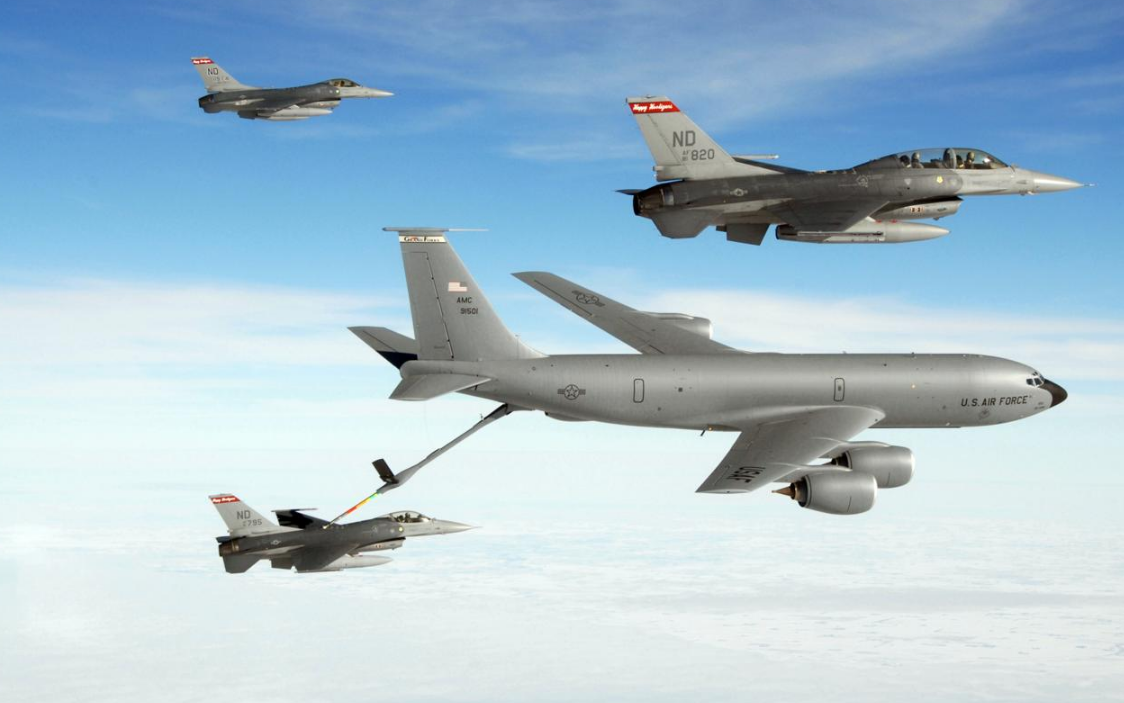
KC-135R refuels F-16s.
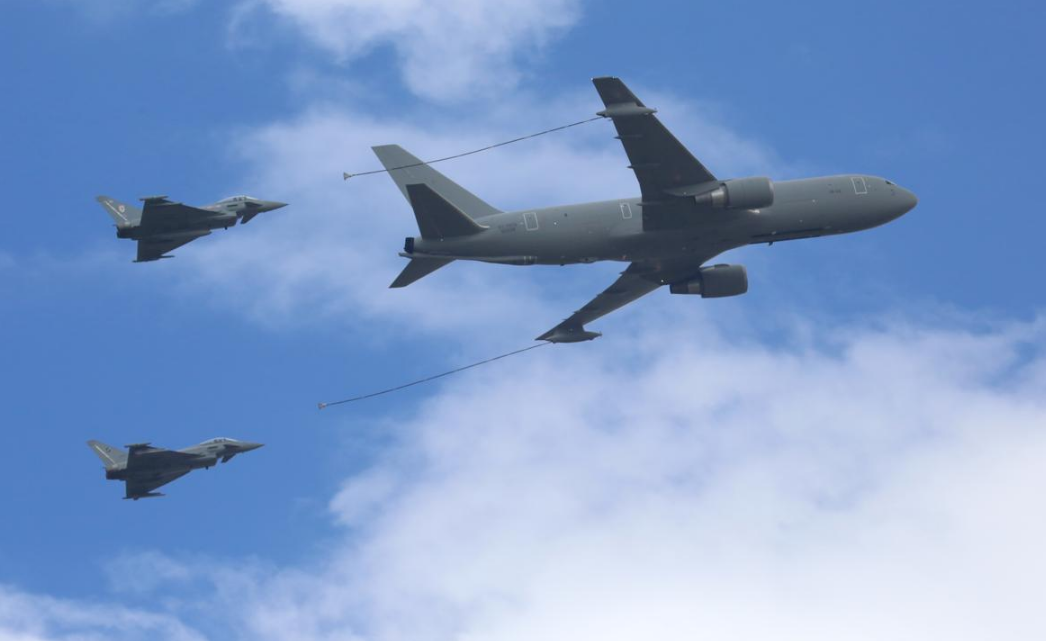
Boeing KC-767A with Italian Air Force EF2000 and RAF Typhoon FGR4.
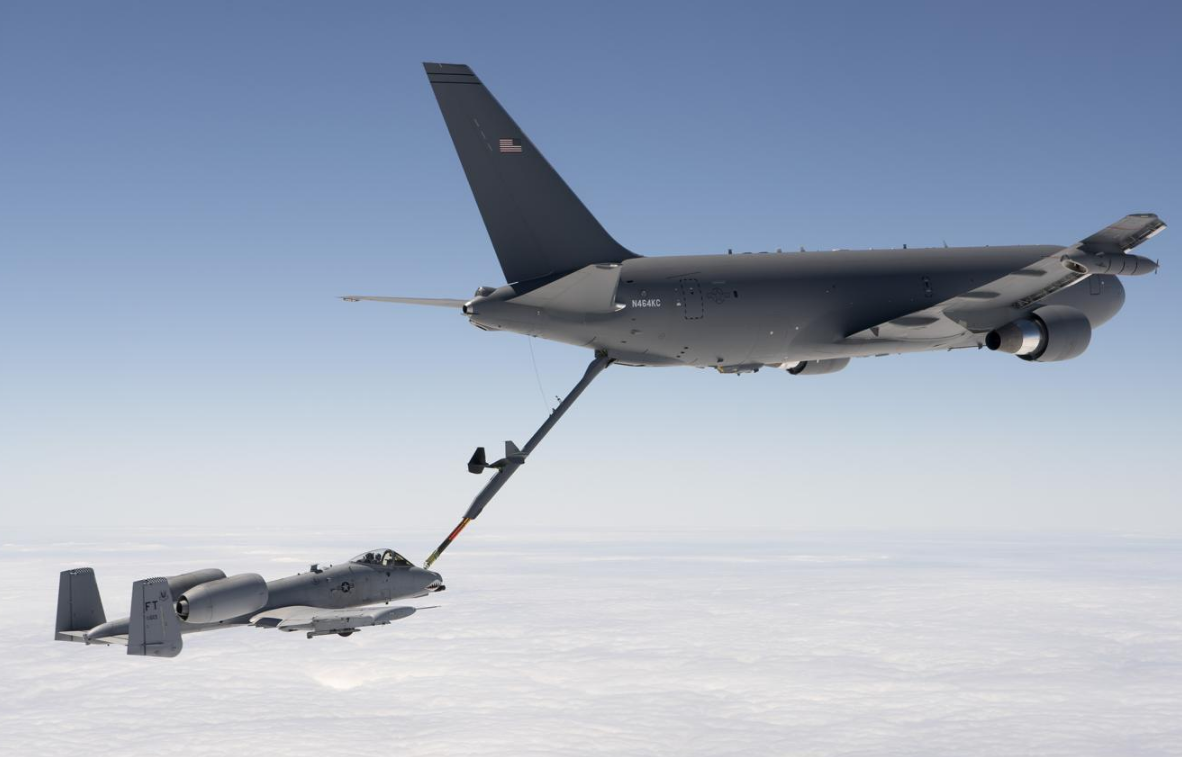
KC-46 refuels A-10 during Milestone C test.
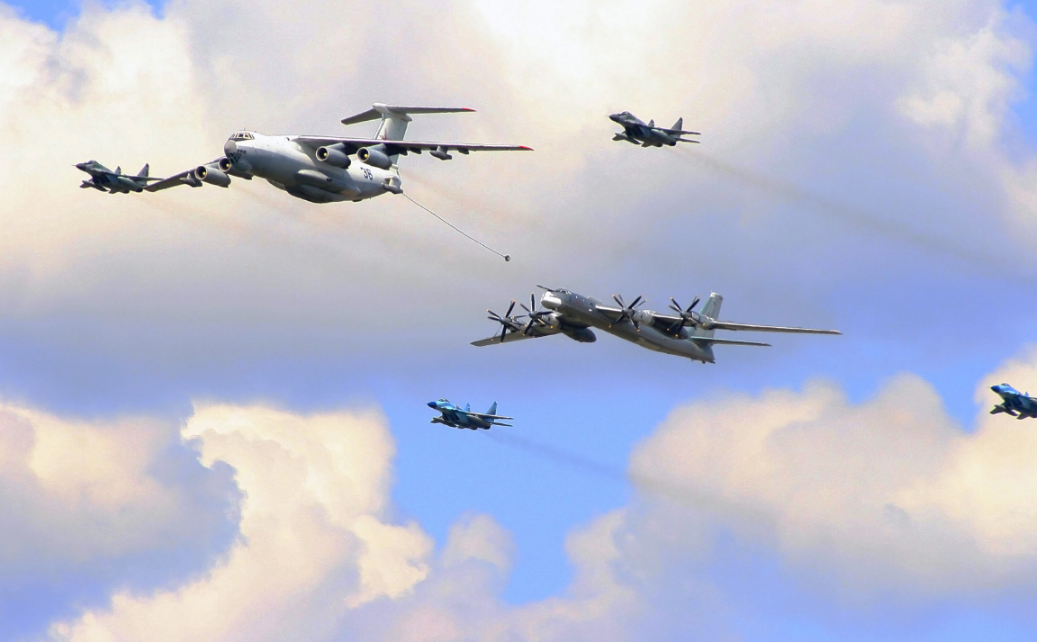
Il-78 and Tu-95 over Moscow on Victory Day Parade.
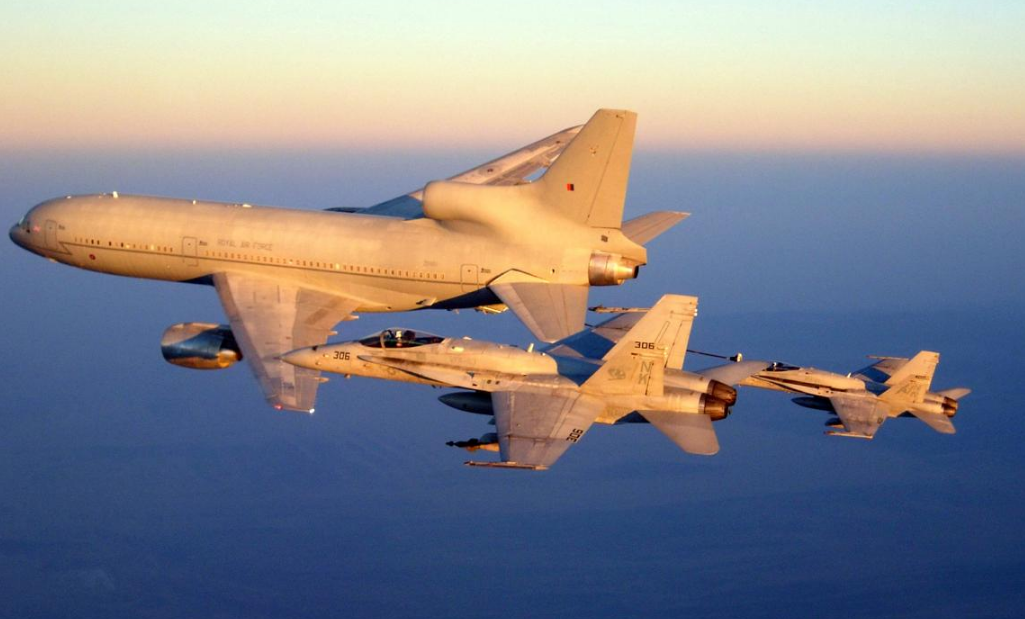
RAF TriStar refuelling US Navy F/A-18s.
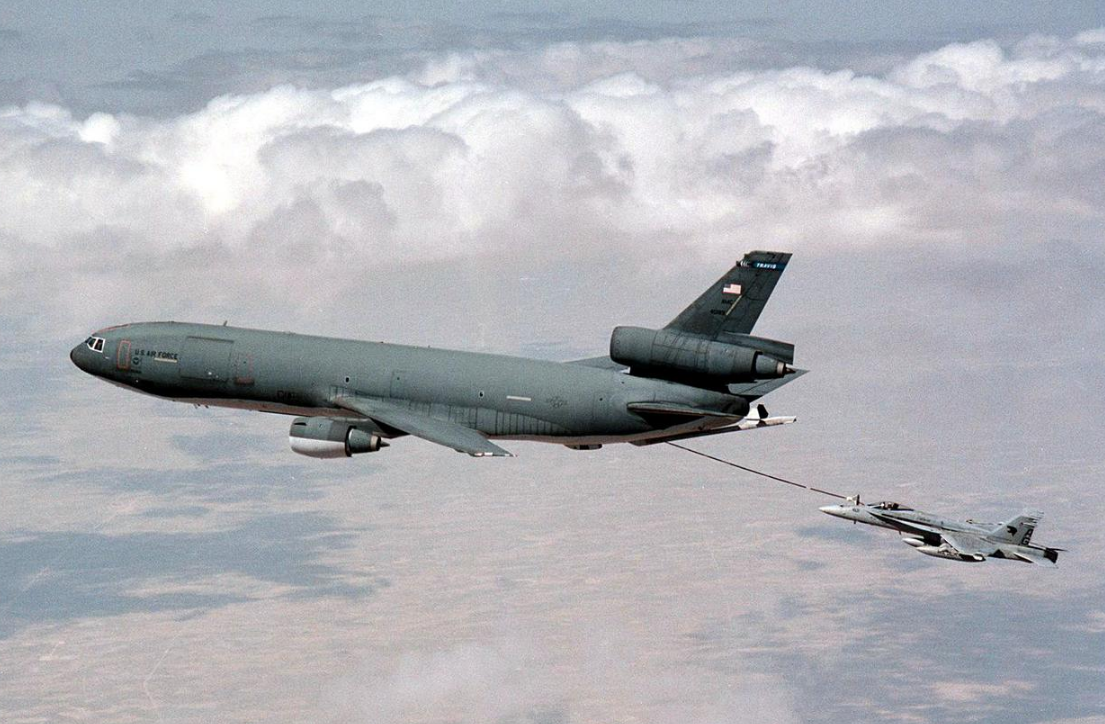
A U.S. Air Force KC-10 Extender refuels a U.S. Navy F/A-18 Hornet.
2. Rotary Wing
Military transport helicopters are used in places where the use of conventional aircraft is impossible. For example, the military transport helicopter is the primary transport asset of US Marines deploying from LHDs and LHA. The landing possibilities of helicopters are almost unlimited, and where landing is impossible, for example densely packed jungle, the ability of the helicopter to hover allows troops to deploy by abseiling and roping.
Transport helicopters are operated in assault, medium and heavy classes. Air assault helicopters are usually the smallest of the transport types, and designed to move an infantry squad or section and their equipment. Helicopters in the assault role are generally armed for self-protection both in transit and for suppression of the landing zone. This armament may be in the form of door gunners, or the modification of the helicopter with stub wings and pylons to carry missiles and rocket pods. For example, the Sikorsky S-70, fitted with the ESSM (External Stores Support System), and the Hip E variant of the Mil Mi-8 can carry as much disposable armament as some dedicated attack helicopters. The assault helicopter can be thought of as the modern successor to the military glider. Finally, there is the generic term utility helicopter, which generally refers to medium-lift designs.
Not all militaries are able to operate a full range of transport helicopters, so the medium transport type is probably the most useful compromise and probably the most common specialist transport type. Medium transport helicopters are generally capable of moving up to a platoon of infantry and are capable of being able to transport towed artillery or light vehicles either internally or as underslung roles. Unlike the assault helicopter they are usually not expected to land directly in a contested landing zone, but are used to reinforce and resupply landing zones taken by the initial assault wave. Examples include the unarmed versions of the Mil Mi-8, Super Puma, and CH-46 Sea Knight.
Heavy lift helicopters are the largest and most capable of the transport types, currently limited in service to the CH-53 Sea Stallion and related CH-53E Super Stallion, CH-47 Chinook, Mil Mi-26, and Aérospatiale Super Frelon. Capable of lifting up to 80 troops and moving small Armoured fighting vehicles (usually as slung loads but also internally), these helicopters operate in the tactical transport role in much the same way as small fixed wing turboprop air-lifters. The lower speed, range and increased fuel consumption of helicopters are more than compensated by their ability to operate virtually anywhere.
2.1. Transport and Utility Helicopters
| Type | Country | Introduction Date | Payload (t) | Maximum Take-Off Weight (t) | Cruise Speed (km/h) | Service Ceiling (m) | Range (km) |
|---|---|---|---|---|---|---|---|
| Aérospatiale SA 321 Super Frelon | France | 1966 | 5 | 13 | 266 | 3,150 | 1,020 |
| Aérospatiale SA 330 Puma | France | 1968 | 7 | 248 | 4,800 | 580 | |
| AgustaWestland AW109 | Italy | 1976 | 3 | 285 | 920 | ||
| AgustaWestland AW101/EH-101 | Italy | 1999 | 8.5 | 15 | 278 | 4,575 | 833 |
| AgustaWestland AW139 | Italy | 2003 | 7 | 306 | 6,096 | 1,250 | |
| AgustaWestland AW149 | Italy | 2003 | 9 | 278 | 6,096 | 800 | |
| AgustaWestland AW159 Wildcat | Italy | 2014 | 1.5 | 6 | 777 | ||
| AgustaWestland CH-149 Cormorant | Italy | 2000 | 8.5 | 15 | 278 | 4,575 | 833 |
| Atlas Oryx | South Africa | 1987 | 8 | 248 | 7,162 | 303 | |
| Bell UH-1 Iroquois | United States | 1959 | 1.7 | 4.3 | 201 | 5,910 | 507 |
| Bell UH-1N Twin Huey | United States | 1970 | 4.7 | 207 | 5,273 | 460 | |
| Bell UH-1Y Venom | United States | 2008 | 3 | 8.3 | 250 | 6,100 | |
| Boeing Vertol CH-46 Sea Knight | United States | 1964 | 2.2 | 11 | 5,180 | 1,020 | |
| Boeing Vertol CH-47 Chinook | United States | 1962 | 11 | 23 | 296 | 6,100 | 370 |
| Changhe Z-8 | China | 1994 | 5 | 13 | 266 | 3,150 | 1,020 |
| Changhe Z-18 | China | 2014 | 5 | 13 | 266 | 6,000 | 1,020 |
| Eurocopter AS365 Dauphin | France | 1978 | 1.5 | 4.3 | 260 | 4,500 | 572 |
| Eurocopter AS532 Cougar | France | 1978 | 1.5 | 9 | 239 | 3,450 | 572 |
| Eurocopter AS565 Panther | France | 1986 | 2 | 4.3 | 260 | 5,865 | 572 |
| Eurocopter EC225 Super Puma/Airbus Helicopters H225 | France | 2004 | 5.5 | 11 | 261 | 5,900 | 857 |
| Eurocopter EC725/Airbus Helicopters H225M | France | 2005 | 5.5 | 11 | 261 | 5,900 | 857 |
| Harbin Z-9 | China | 1994 | 1.5 | 4.3 | 260 | 4,500 | 572 |
| IAR 330 | Romania | 1975 | 7.5 | 271 | 6,000 | 572 | |
| Mil Mi-8 | Russia | 1967 | 4 | 13 | 230 | 4,500 | 610 |
| Mil Mi-17 | Russia | 1977 | 4 | 13 | 230 | 6,100 | 610 |
| Mil Mi-26 | Russia | 1977 | 20 | 61.7 | 255 | 4,600 | 800 |
| NHIndustries NH90 | European Union | 2007 | 2.5 | 11 | 6,000 | 800 | |
| Sikorsky UH-60 Black Hawk | United States | 1979 | 4 | 10 | 280 | 5,790 | 590 |
| Westland Lynx | Italy | 1978 | 1.5 | 5.5 | 528 |

Kazakh Mi-17 helicopter; some members of the Mil Mi-8 family can carry both weapons and troops
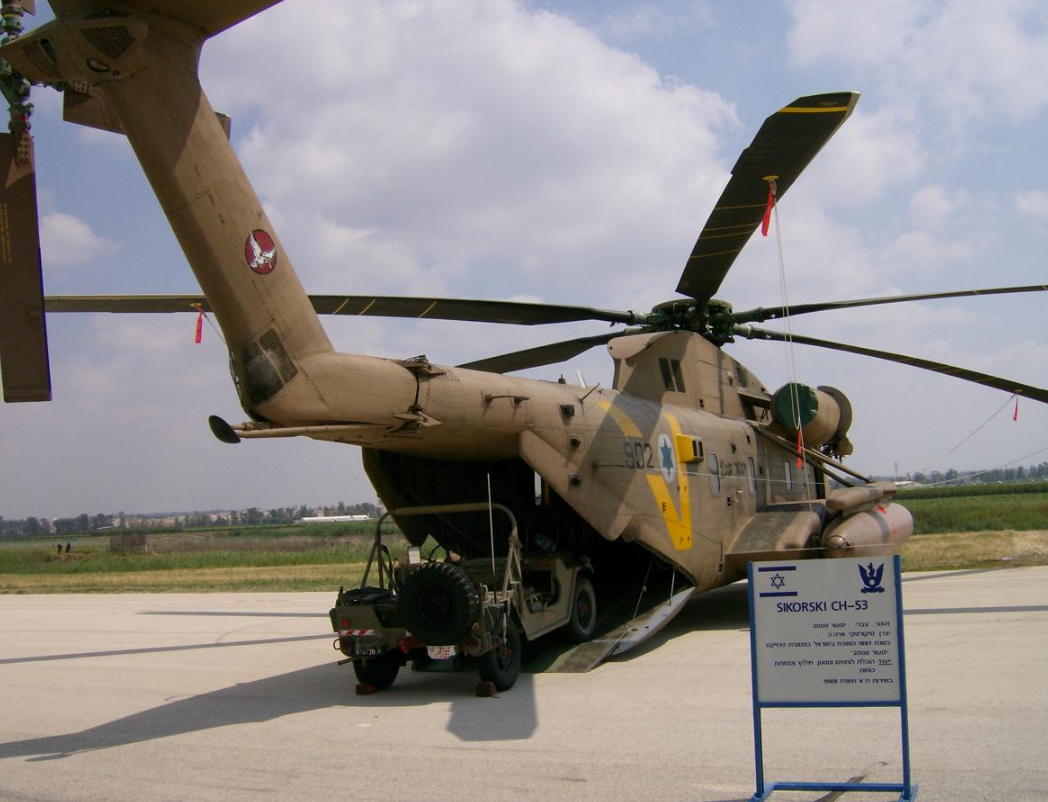
CH-53 with possible internal load
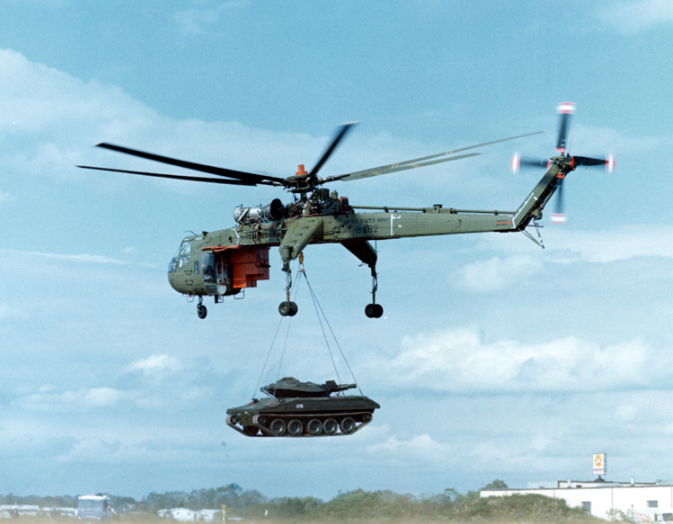
CH-54B carrying an M551 Sheridan tank
References
- "Study into the impact of the global economic crisis on airframe utilisation". Eurocontrol. January 2011. p. 21. https://www.eurocontrol.int/sites/default/files/content/documents/official-documents/facts-and-figures/coda-reports/study-impact-global-economic-crisis-2011.pdf.




